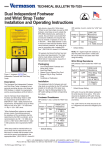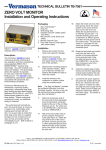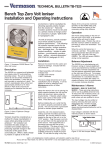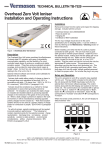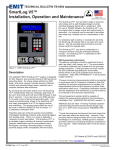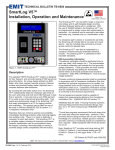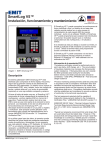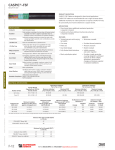Download TB-7534 - Vermason
Transcript
TECHNICAL BULLETIN TB-7534 Dual Independent Footwear Tester Installation and Operating Instructions “Where toe and heel straps are used as ESD footwear, once these are worn outside the EPA (ESD protected area), particularly on carpets, they are likely to accumulate fluff and become ineffective; this requires that they be checked or replaced on every visit to the EPA. …When ESD footwear is used, it should be noted that ESD footwear alone cannot achieve protection, but needs to be used in conjunction with a suitable ESD floor.” (EN 61340-5-2 clause 5.2.8 Footwear) “All wearers shall check that their heel and toe straps meet requirements. The check shall be made before entering the EPA.” (EN 61340 5-1 Daily checks, clause 9.6.3 Non-permanent footwear) Packaging DIP switches 3 and 4 control the “LOW” test limit. LOW Limit Switch 3 Switch 4 Resistance ON OFF 100 Kilohms (1 X 10E5) OFF ON 750 Kilohm (7.5 X 10E5)* NOTE: At 1 Gigohm high limit resistance, a dirty foot plate could result in a false pass. Be sure to keep the foot plate clean particularly when using this setting. Audio Adjustment Foot Plate Jack 1 1 1 1 Figure 1. Vermason 222690 Dual Independent FootwearTester and Dual Foot Plate Description The Vermason Dual Independent Footwear Tester is a 6-state touch tester designed for fast and frequent testing of ESD personnel footwear. This Tester can be used to verify that the ESD footwear resistance circuit is within the proper limits. By depressing the electrode button once, the Dual Independent Footwear Tester tests the resistance path limits of both worn ESD footwear independently within three seconds. The footwear resistance range can be changed by changing the positions of the DIP switches. Use the Vermason Dual Independent Footwear Tester to fulfill the requirements of EN 61340-5-1. “When the footwear/floor systems are used as the primary means of grounding personnel, the resistance of the combination shall be determined by the ESD coordinator, and is recommended to be between 7.5 x 10E5 ohms and 3.5 x 10E7 ohms” (EN 61340-5-1 Table 1 ESD Protective Items Requirements NOTE 2). Dual Independent Footwear Tester Dual Foot Plate Stereo Plug to Stereo Plug Cord Banana Plug to Ring Terminal Cord 1 Certificate of Calibration Made in America Installation Relay Ground Jack FRONT VIEW The resistance limits for footwear tester is controlled by the DIP switches located on the left-side of the tester (see Figure 2). See the following tables for the DIP switch settings and their corresponding test values. FOOTWEAR RESISTANCE DIP switches 1 and 2 control the “HIGH” test limit. * Default Setting HIGH Limit Switch 1 Switch 2 Resistance ON ON 10 Megohms (1 X 10E7) OFF OFF 35 Megohms (3.5 X 10E7)* ON OFF 100 Megohms (1 X 10E8) OFF ON 1 Gigohm (1 X 10E9) * Default Setting DIP Switch Power Jack SIDE VIEW Figure 2. Dual Independent Footwear Tester side views INSTALLING THE TESTER AND FOOT PLATE Mount the tester at the desired location using the four mounting holes in the corners of the yellow mounting plate. Set the foot plate below the tester. Insert one end of the Stereo Plug to Stereo Plug cord into the stereo jack located at the bottom of the tester (see Figure 2). Insert the other end of the cord into the stereo jack at the back of the foot plate. UNIT C, 4TH DIMENSION, FOURTH AVENUE, LETCHWORTH, HERTS, SG6 2TD UK Phone: 0044 (0) 1462 672005, Fax: 0044 (0) 1462 670440 • e-mail: [email protected], Internet: Vermason.co.uk TB-7534 December 2008 Page 1 of 3 © 2008 Vermason Insert the banana plug end of the Banana Plug to Ring Terminal cord into the ground jack located at the bottom of the tester (see Figure 2). Connect the ring terminal end of the cord to earth ground. This connection will remove any static charge from the user before the test. NOTE: Failure to correctly ground the tester may result in damage not covered under warranty. Left Foot Insert the power supply plug into the power jack located on the left-side of the tester (see Figure 2). Plug the power supply into an appropriate power outlet. RELAY TERMINAL A relay with both "normally open" and "normally closed" contacts is included for your convenience. Going from left to right, the terminal block on the bottom of the tester has terminals for "normally closed," "common," and "normally open" (see Figure 3). The relay can be used for opening an electric lock to an ESD sensitive area. The maximum contact rating is: 1A@30VDC. Operation Upon power up, the alarm will sound and all of the LEDs for the activated tests will be illuminated. The tester is now ready for use. Pushing the touch plate on the front panel starts the test. During the test all LEDs will turn off to indicate that a test is in progress. The touch plate must remain depressed until the test results are displayed. Depending on the configuration of the tester, the test could require up to three (3) seconds. The resistance is checked from the touch plate to the corresponding foot plate for each foot. The LED(s) will turn off while the test is in progress. The test results for each foot will then be displayed for approximately three (3) seconds. If all tests result in a "PASS" condition, the internal relay will activate. If any of the test results fail "HIGH" or "LOW," an audible alarm will sound. The LED(s) indicating the failed test will be displayed for approximately three (3) seconds, and the internal relay will not activate. Right Foot Test Push Button 1 2 3 1 & 2 = Normally closed Relay 2 & 3 = Normally open 1 A @ 30 VDC (Rating) Figure 3. Dual Independent Footwear Tester features and components Specifications Rated tester voltage: 12 VDC, 600 mA, (2.5 mm connector center positive) Relay contact rating: 1 A @ 30 VDC max Temperature range: 41°F - 104°F (5°C - 40°C) Operating conditions: Indoor use only at altitudes less than 6500 ft. (2 km). Maximum relative humidity of 80% up to 88°F (31°C) decreasing linearly to 50% @ 104°F (40°C). Pollution degree: 2 per IEC 644 A periodic check (once every 6 to 12 months) using a precision resistance box should be performed to verify proper operation. The Vermason 222693 Limit Comparator is available for the convenient periodic testing of the Dual Independent Footwear Tester (see Figure 4). The Vermason Limit Comparator allows the customer to perform NIST traceable calibration on a number of Vermason Testers including the 222690 and 222700. The Limit Comparator can be used on the shop floor within a few minutes virtually eliminating downtime, verifying that the Dual Independent Footwear Tester is operating within tolerances. Calibration The Vermason Dual Independent Footwear Tester is calibrated to standards traceable to NIST. Frequency of recalibratrion should be based on the critical nature of those ESD sensitive items handled and the risk of failure for the ESD protective equipment and materials. In general, we recommend that calibration be performed annually. The accuracy of the Dual Independent Footwear Tester is specified as: • ±5% for 1 x 10E6 Megohm and lower resistance ranges • ±10% for 1 x 10E6 Megohm and higher resistance ranges Figure 4. Vermason 222693 Limit Comparator UNIT C, 4TH DIMENSION, FOURTH AVENUE, LETCHWORTH, HERTS, SG6 2TD UK Phone: 0044 (0) 1462 672005, Fax: 0044 (0) 1462 670440 • e-mail: [email protected], Internet: Vermason.co.uk TB-7534 Page 2 of 3 © 2008 Vermason USING THE 222693 LIMIT COMPARATOR Footwear Operation Test I. Insert the Limit Comparator’s test plug into the phono jack located on the Dual Foot Plate. II. Select the appropriate FAIL LOW setting on the Limit Comparator. III. Press and hold the touch plate of the tester until the test is completed. The tester should indiciate a FAIL LOW condition for both feet. IV. Select the appropriate PASS LOW setting on the Limit Comparator and repeat the test. The tester should indiciate a PASS condition for both feet. V. Select the appropriate PASS HIGH setting on the Limit Comparator and repeat the test. The tester should indiciate a PASS condition for both feet. Limited Warranty Vermason expressly warrants that for a period of one (1) year from the date of purchase, Vermason Dual Independent Footwear Testers will be free of defects in material (parts) and workmanship (labour). Within the warranty period, a unit will be tested, repaired or replaced at Vermason’s option, free of charge. Call Customer Service at 0044 (0) 1462 672005 for a Return Material Authorisation (RMA) and for proper shipping instructions and address. Any unit under warranty should be shipped prepaid to the Vermason factory. You should include a copy of your original packing slip, invoice, or other proof of purchase date. Warranty repairs will take approximately two weeks. If your unit is out of warranty, Vermason will quote repair charges necessary to bring your unit to factory standards. Call Customer Service at 0044 (0) 1462 672005 for a Return Material Authorisation (RMA) and proper shipping instructions and address. Warranty Exclusions THE FOREGOING EXPRESS WARRANTY IS MADE IN LIEU OF ALL OTHER PRODUCT WARRANTIES, EXPRESSED AND IMPLIED, INCLUDING MERCHANTABILITY AND FITNESS FOR A PARTICULAR PURPOSE WHICH ARE SPECIFICALLY DISCLAIMED. The express warranty will not apply to defects or damage due to accidents, neglect, misuse, alterations, operator error, or failure to properly maintain, clean or repair products. Limit of liability In no event will Vermason or any seller be responsible or liable for any injury, loss or damage, direct or consequential, arising out of the use of or the inability to use the product. Before using, users shall determine the suitability of the product for their intended use, and users assume all risk and liability whatsoever in connection therewith. VI.Select the appropriate FAIL HIGH setting on the Limit Comparator and repeat the test. The tester should indiciate a FAIL HIGH condition for both feet. UNIT C, 4TH DIMENSION, FOURTH AVENUE, LETCHWORTH, HERTS, SG6 2TD UK Phone: 0044 (0) 1462 672005, Fax: 0044 (0) 1462 670440 • e-mail: [email protected], Internet: Vermason.co.uk TB-7534 Page 3 of 3 © 2008 Vermason



